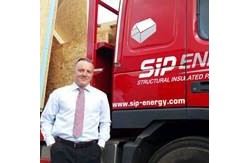SIP Energy Ltd is one of Europe's leading modern method of construction companies. The company was formed in 2005 when brothers Micheal and Sheamus Quinn brought 30 years of insulated composite panel technology and expertise from their refrigerated and vehicle business to the construction industry.
Their philosophy is simple: they focus on the principle that everything can and will be made better, more efficient and more future-proof. Structural insulated panels are composed of two solid timber OSB faces which are laminated to a highly efficient core of insulation. Used for the walls and roofs of buildings, this gives market-leading thermal performance, air tightness, as well as speed and quality of build for new homes, schools, commercial buildings and care facilities - the list of uses is endless.
In a climate of increasing energy costs and a necessity to build better and more efficient buildings, the single biggest factor in ensuring an efficient and quality building is the building envelope - the package of walls and roof.
Traditional build methods rely on multiple trades to come together. SIP Energy provides a one-stop solution. They take the architects' plans and convert them in a 3D SIP model and manufacture them at their manufacturing facility in Athenry, Co Galway. All the SIP panels are CNC machined to the finest tolerances in the construction industry. Finally, the system is installed on a site.
Eugene McMahon, Partner, Mazars writes: SIP Energy has recently formed a UK company and has sales people employed there. The key question is whether the UK company will drive increased sales. If a company is selling, say, electronic goods over the internet, then incorporating in other countries does not make sense.
However, for a company like SIP Energy, it does make sense. A customer is buying the frame of a house from SIP Energy. It is one of the most expensive and important decisions that a person will ever make. Will that person be more comfortable dealing with representatives of a company that are based in the same country? The answer is probably yes.
In many cases, a branch in the other country - as opposed to a subsidiary company - would achieve the desired results. However, in SIP's case, a branch was not considered an appropriate commercial footprint. When deciding to incorporate a foreign subsidiary, its commercial form needs to be considered carefully. In early stage export market development, a limited-risk distributor is the best option. The limited risk distributor will not take on the inventory, foreign exchange or credit risk. It merely contracts with the customer and is supplied with the specific goods by its parent for the specific contract. Its profit is restricted to an agreed commission, with the parent realising the bulk of the profit.
Paul Mee, Partner, Mazars writes: While there are a number of tax issues warranting consideration when looking to establish a presence in a foreign market, it is critical that a business decision is made for commercial reasons and it is only then that the tax issues are assessed. Commercial comes first; tax is second.
Where a limited-risk distribution model is the preferable commercial option, a key issue is ensuring that the level of commission payable is acceptable to the foreign tax authority. However, as a limited-risk distributor has no real commercial exposure on a sale, this commission could potentially be set a relatively low rate.
A key tax point when considering whether to enter a new market by way of a branch or a new subsidiary, is the projected financial performance over the next number of years.
If the operation is likely to be loss-making, from a tax perspective there would be a preference to operate as a branch. This will enable access to the foreign trading loss in the "home" jurisdiction (eg Ireland). This could help to reduce the immediate amount of tax payable. This treatment differs where the losses are incurred in a subsidiary. In general, the losses of a foreign subsidiary are ring-fenced to that entity and are not available for offset against other group profits. This could result in an increased effective group tax rate.
Lorcan Colclough, Partner, Mazars writes: SIP Energy is focused on exporting its products overseas. When expanding internationally, consideration must be given to the legal structure that would best fit an overseas business. There are two main options available for establishing a business in a new jurisdiction: establishing a branch or establishing a subsidiary company.
Establishing a branch is essentially an extension of the existing company. This gives the business a presence in the new jurisdiction at a relatively low cost. There are no additional capitalisation requirements, no need to create additional management structures, and a branch can be closed relatively quickly if the new venture does not go according to plan.
While establishing a branch has many advantages, the preferred route to new markets for most prudent entrepreneurs is forming a subsidiary company. While forming a subsidiary company effectively duplicates the administrative burden of running a company, the protection of limited liability for the shareholders of limited companies means that any potential losses of the new venture can be ring-fenced and restricted to the amount of capital that the business owners are willing to contribute. In simple terms, the assets of the existing company can be protected against any failings of the new venture.
Source: Independent









